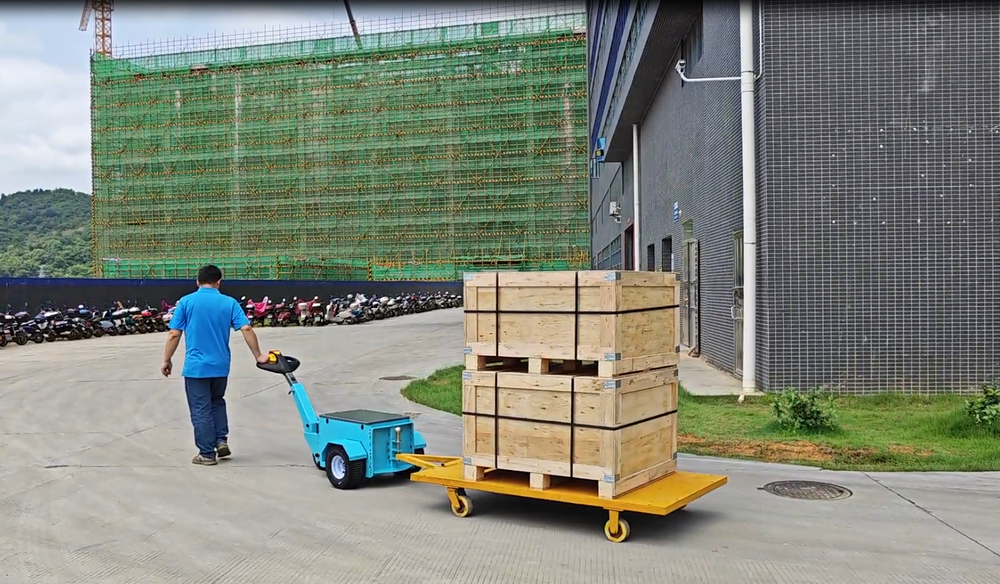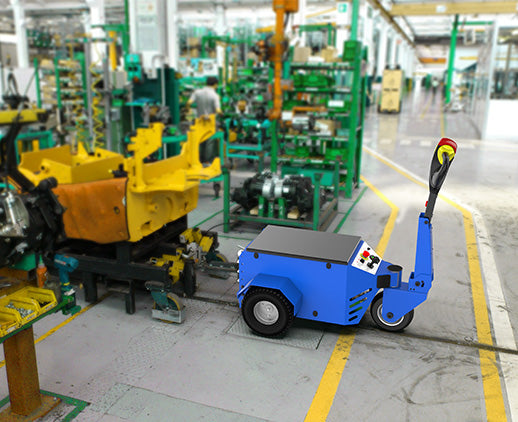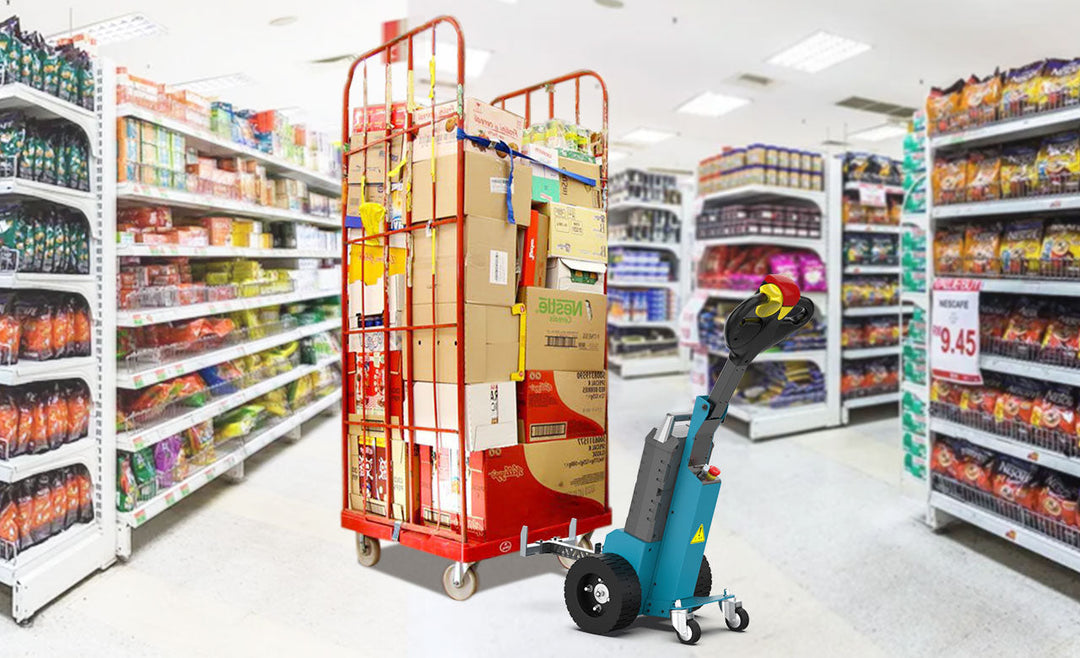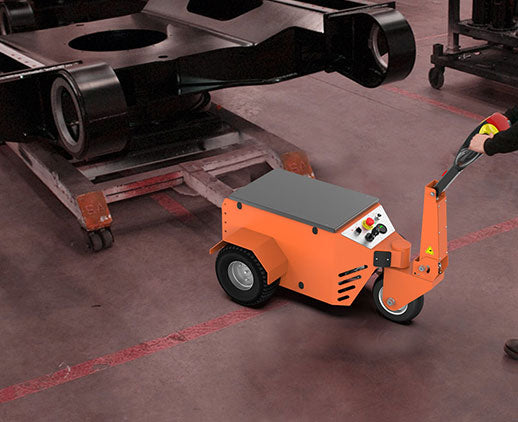What is an electric airplane tug? A Beginner Guide to plane tug
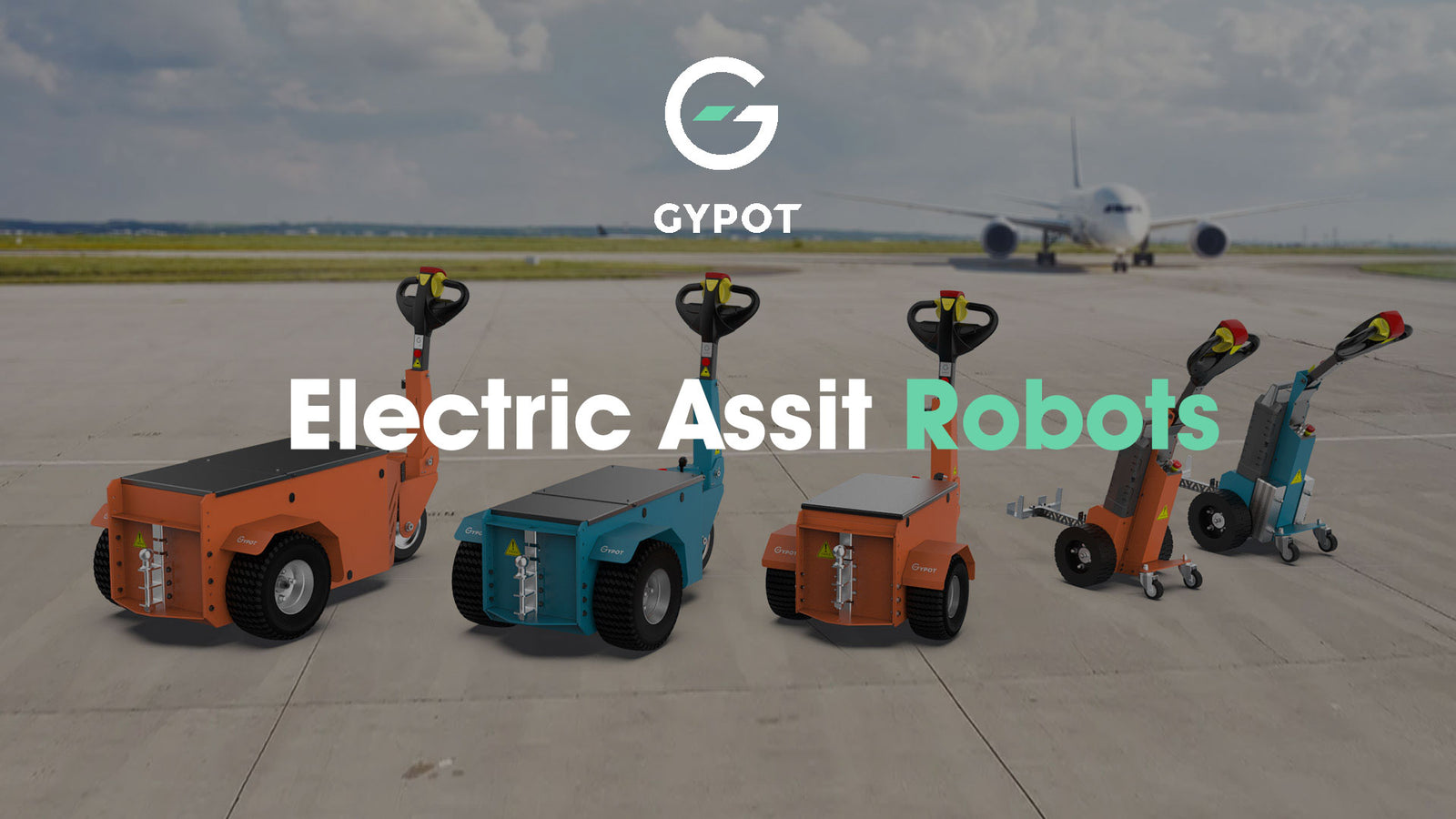
Electric airplane tugs, also called aircraft tow tractors or tugs, are vehicles used to displace an airplane on the ground without using the engines of the aircraft. The serviceability of these tugs is vital for a number of different grounded airport operations, like the rearrangement of airplanes for maintenance, parking, and gate management.
How Do Electric Airplane Tugs Work?
Electric airplane tugs have showcased their effectiveness and sustainability in airport ground operations. In contrast to diesel or gas-brunners, e-tugs can perform the same function without making noise or, more importantly, emitting noxious stuff and are frequently cheaper to operate. So, here is what each of them is made of and what they do to operate in these tugs:
Electric Motors
If that excites you, you may be interested in considering electric airplane tugs, the leading mechanism for manually moving aircraft back from the airport gate...and which are driven by electric motors providing the torque required to get aircraft moving. From the batteries, this electrical energy is converted into mechanical energy that allows the tug to pull or push aircraft efficiently, using a variety of motors. The electric motors in these tugs produce significant torque, over 1,000 Nm (Newton meters), and that torque is typically more than enough to push (or pull) everything from small regional jets to superjumbos.
Batteries
Electric airplane tugs are powered by batteries that store and discharge energy to the motors. Lithium-ion batteries are the current standard in tugs due to higher energy densities, extended life spans, and faster charge cycles compared to traditional lead-acid batteries. The tug can operate for many hours on a single charge, depending on how much load has been demanded from the tug and also the size/weight of the aircraft being serviced.
For example an average electric airplane tug could possibly have among 60 kWh to as a lot as 300 kWh of usable electric battery. This enables several movements of aircraft before needing to be recharged, which allows for high reliability and low downtime.
Control Systems
Electric airplane tugs see control systems that enable operator to manipulate the tug accurately. These can be anything from joysticks and touchscreens to other interfaces that help render the transfers as precise and effective. Advanced control systems can also include automated features like collision avoidance and autopilot modes to improve safety and reduce human error.

Methods And Concept For Using Towbar Or Towbarless Mechanism
Electric airplane tugs either have a towbar connected to the tug in the front that the operator pushes or pulls to and from the aircraft, or they are towbarless.
Towbar Tugs - These tugs are connected to the aircraft's nose landing gear by a towbar. A towbar is a firm bond that helps to properly attach and to enable the pull power of the tug through the aircraft. We have different towbar adapters that allow our towbar tugs to be utilized for a variety of aircraft types.
Towbarless Tugs: These tugs lift the nose wheel of the aircraft, so that the towbar required to pull the aircraft is not needed. The biggest benefits of using towbarless tugs are faster connection for pushback services and added maneuverability. Likewise, it can take the traditional towbar tugs 5 or more minutes to secure a connection to an aircraft whereas towbarless tugs can often at the door of a plane and moving in less than two minutes.
Electric Tugs vs Conventional Tugs - The Main Differences
Below are a few key differences between electric airplane tugs and the more traditional diesel or gasoline-powered tugs.
Impact on the Environment: Electric tugs emit no greenhouse gasses - some can argue if the energy is not generated by proxies burning coal at a power station first, they still have a regular environmental impact than necessarily anything better than that of a diesel tug.
On the other hand, noise levels are greatly reduced as electric tugs have no internal combustion engine, a huge benefit for both airport workers and the local community, as less noise pollution is generated.
The Most Expensive Costs: Compared with gas-powered tugs, electric tugs generally have lower operating costs because they require less fuel and maintenance. As an example, electricity is generally cheaper than diesel or gasoline, and electric motors are much simpler than internal combustion engines and require less maintenance.
Performance and Efficiency: Electric tugs are designed provide the consistency and reliability of the performance and instant torque delivery from the electric motors. This direct power response can greatly optimize ground-handling movements of aircraft.
Application & Advantages
These devices are used in an airport for various tasks like moving planes for maintenance, parking, and gate management. With their high precision control systems and dependable power delivery, they are a critical part of the operation of a modern airport.
Through the adoption of electric tugs, airports can experience substantial improvements in their operational efficiency, ecological footprint and economic expenditures, thus securing their place as the next chapter in the aviation ground support story.

Benefits of Electric Airplane Tugs
The benefits of electric airplane tugs over their diesel or gasoline predecessors are many. The Top Explained Benefits
Environmental Impact
Electric airplane tugs significantly reduce emissions to create cleaner air on airport grounds. Conventional tugs powered by diesel or gasoline produce green house gases and air pollutants such as carbon dioxide (CO2) and nitrogen oxides (NOx), particulates (PM). By comparison, pure battery-powered electric tugs are emission-free in operation -thus helping airports to lower air pollution-related CO2 emissions. As an example, an electric tug translates to a 1000 to 2000 gallon annual savings in diesel fuel and 10 to 20 metric tons of CO2 emissions every year.
Cost Efficiency
With reduced operational expenses from fuel and maintenance costs, there emerges savings of money, time, and energy in using electric airplane tugs. This makes their overall cost of ownership many times cheaper in comparison to the one powered by diesel and gasoline, since electricity is, in general, cheaper. On top of that, electric motors have much fewer moving parts than gas engines, lowering maintenance needs and costs (image: General Motors) An airport, for example, ideally pockets thousands of dollars a year per tug by going electric when you factor in fuel and maintenance costs.
Noise Reduction
Flightline's electric airplane tugs aren't silent, but they're a lot quieter than diesel or gas tow vehicles. This more silent operation means that for the ground crew workers at airports and near by communities, another noise control has been put into place. The noise levels of electric tugs are said to be 20 decibels lower than traditional tugs, thereby contributing to the carbon footprint of the airport.
Improved Safety
Electric airplane tugs have very sophisticated control systems which help to improve the safety of ground operations. If a successful test flight is made, this control system will enable the smoothest and most accurate maneuvering, thereby doing away with potential risks of accidents and virtually eliminating the possibility of any harm done to the aircraft. Electric tugs are available with high-tech safety features that include collision avoidance systems, automatic brakes, and better visibility to operators. One example is electric tugs with sensors and cameras that can detect obstacles, and stop or adjust accordingly to prevent accidents to a large extent.
Electric airplane tugs help ground staff as well With all these perks, electric airplane tugs are also providing better conditions for ground staff. This can mean a cleaner, quieter place of work for employees and an environment where they may be able to work more comfortably and perhaps even more productively.

Types of Electric Airplane Tugs
There are two primary types of electric airplane tugs, towbar tug and towbarless tug, with advantages of each for a given type of an airplane tug. Types of Runway Sweepers -Knowing The Difference And When To Use ThemChoosing the right equipment for specific airport operations starts with understanding the differences between the types available.
Towbar Tugs
They get connected to the nose landing gear of the airplane using a towbar. These tugs are extremely flexible and can pull a variety of aircraft with the right towbar adapter. Whilst the towbar needs to be manually attached and removed, this makes for a very robust connection to the aircraft.
Advantages:
Simplicity:Towbar tugs can be transformed into towing vehicles for various aircraft, ranging from small regional jets to wide body commercial airliners, with the use of towbar adapters. This, it says, makes them ideal for airports that have fleets using different fuels.
Drag-induced stability: The towbar's rigid attachment directly eliminates any whip or slop in the aircraft-towbar connection: a very important feature when towing aircraft near other aircraft in congested areas.
Applications:
Maintenance and Repositioning: Perfect for taxiing from hangars to maintenance areas and parking, etc.
Gate management: It helps in the management of gates, especially in airports servicing mixed fleets.
Towbarless Tugs
Towbarless tugs lift the nose wheel of the aircraft itself - without the aid of a towbar. This setup provides quicker connect times and is typically easier to operate than towbar tugs. Using a hydraulic system, towbarless tugs secure the nose wheel and lift it up thereby providing a positive and robust connection.
Advantages:
Speed: With tugs only able to connect to the front of an aircraft by design, towbarless tugs can hook up to an aircraft in under two minutes whereas traditional towbar tugs often take five minutes or more. This speed could reduce turnaround times and contribute to increased airport efficiency overall.
Ease of Operation: Without the towbar, the operation is effectively many times easier, requiring less physical effort from the ground crew and minimizing the risk of anything not getting connected correctly
Maneuverability(ability to move around): Towbarless tugs have better maneuverability - making it easier to take tight turns and position precisely on crowded airport - than the towbar tugs.
Applications:
Quick Turnaround: Ideal for fast gate switches and moving planes into yhe gate for boarding and deplaning.
Tight Spaces-Great for tight locations like jammed gates or busy aprons.
Towbar Tugs Vs Towbarless Tugs
Performance and Speed:
Towbar Tugs-Provide reliable gas or electric solutions but are slow to hitch and unhitch, thus affecting efficiency during busy times.
Towbarless Tugs: These are ideal for high-paced operations needing quick turnaround due to faster connection and disconnection times.
Flexibility and Adaptability:
Towbar Tugs : Very versatile between aircraft with the right towbar (GSE type), good for airports with a variety of equipment.
Towbarless Tugs - also versatile, it is more suitable for some types and sizes of aircraft, particularly larger commercial jets.
Operational Simplicity:
Towbar Tugs: Need to be operated with caution, and you must choose the right towbar to operate as such, increasing set-up complexity.
Towbarless Tugs: Easily hook-up and Superior maneuverability.
All of which means that both the electric airplane tugs have their own vital functions within the wider operation of a modern airport. Having the right tug allows airports to maximize their ground handling capabilities and ensures the most efficient, safe ground operation is made.

How to Operate an Electric Airplane Tug
Driving a electric airplane tug will require training and certification to handle safely and efficiently the airplanes. Operating an electric airplane tug Since you now know the basic things about an electric airplane towing, let us focus on some detailed steps on how to operate an electric airplane tug.
Pre-Operation Checks
Pre-operation Inspections to Perform Before Using an Electric Airplane Tug
Look Over the Tug: Make sure there are no problems with the tug or any defects. Inspect and check for visible signs of damage and ensure the proper function of all controls.
Batteries: Check if the batteries are charged fully. Many electric tugs also have battery level meters. The tug can solve all its missions with just one battery charge.
Safety and test functions are one of the next large categories, with the preview area taking up the most space, in the game this activates other diagnostic functions for example the diagnosis of joysticks, touchscreens or the recognition of the collision sensors. Use the test runner to validate the responsiveness of your commands.
Connecting to Aircraft
Aircraft need properly connected to a tug for safe operations:
Towbar Tugs:
Choose the correct towbar adapter relevant to the aircraft type
Place the tug in front of the fuselage; at the nose landing gear.
Secure the towbar to both the tug and the nose gear of the aircraft. Make sure all connections are snug and seated.
Make sure the towbar is aligned and that the nosewheel of the aircraft is located in the towbar attachment.
Towbarless Tugs:
Put the tug right in front of the nosegear on the airplane.
This will allow you to pressurize the hydraulic system and raise the nose wheel.
After centering the nose wheel, ensure that the nose wheel is properly centered and locked into the lifting mechanism of the tug.
Please verify all connections and locks before continuing!!
Maneuvering
The precision and close maintenance of safety standards needed to use the control systems to move the aircraft:
Control Systems: Navigaton of the tug is done via joystick or touchscreen controls. Nearly all electric tugs have intuitive control systems allowing the movement to be smooth and accurate.
Adjust speed and direction gradually to prevent sudden movements that could upset the attitude of the aircraft.
Adherence to Safety Protocols: Keep restrictions that apply to driving on an airport.ir, maintain the proper speeds, use prescribed paths, and you will be expected to actively communicate with ground control. So like, always pay attention to your environment, yo.
Disconnecting
Release the tug after the aircraft is properly aligned.
Towbar Tugs:
Cease the pull and then set the parking brake.
Unhook the towbar from the nose gear of the plane and from the tug.
Caution: Gently remove towbar from the aircraft and position it off to the side of the aircraft.
Towbarless Tugs:
Engage the parking brake on the tug.
Lower the nose wheel of the plane via the hydraulic system
Do not lift away until the nose wheel is grounded firmly.
Very carefully and slowly, move the tug away from the aircraft.
Other Tips in Handling a Forklift Safely
Application: Communicate effectively with NDZ, the rest of ground control, and all other ground crew present during operation. Use hand signals or radios as required.
Predictive Maintenance: Periodic Maintenance before any issue/errors occurred in tug. Battery and other inspection and maintenance such as tire condition, mechanical inspections etc.
TrainingMake sure all organisational members are trained and certified. Also, try to refresh your skills through refresher courses more regularly to stay current with the most up-to-date safety procedures and technology.




